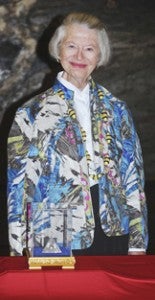Medallion returned to Philippines
Published 12:05 pm Friday, March 15, 2013
A medallion worn by freedom fighter Emilio Aguinaldo, first president of the Philippines, was returned to the National Museum in Manila March 9 by a Cass County woman.
Barbara Cook, former Southwestern Michigan College trustee and Pokagon Township supervisor, spoke about the World War I general given the medallion.
Constantine native Harry Hill Bandholtz was chief of the Philippine Constabulary, 1907-1913.
Cook’s late husband Grafton “Grif,” collected artifacts exhibited at the SMC museum, though most were donated in 2000 at the Chicago Philippine Consulate.
Director Jeremy Barns; architect Augusto Villalon, a member of the National Museum Board of Trustees; and Cook unveiled the Bandholtz medallion and formally presented it to the National Museum and the people of the Philippines.
Saturday morning’s activities concluded with a response on behalf of the National Museum from Villalon, who graduated from the University of Notre Dame.
“We were treated like royalty,” she said.
Manila, the capital, became the seat of colonial government of Spain when it controlled the Philippine Islands for more than three centuries, 1565-1898.
Beginning in 1898, the United States occupied and controlled the city until independence was granted in 1946. During World War II, much of the city was destroyed. While a Spanish colony, they were governed through Mexico.
Ships from the Far East unloaded at Acapulco, transported across Mexico, then loaded back onto anther ship and forwarded on to Spain.
This was unsatisfactory to Filipinos, who wanted Spain to recognize them as equal to Mexico and not its stepchild.
“Considering that the program was presented on a lovely Saturday morning, a nice number of people were in attendance,” Cook said. “Afterwards, we enjoyed a very delicious, congenial luncheon. At that time, I was given a lovely book, ‘Treasures of the San Diego,’ which provides pictures and text about the wreckage of an early Spanish galleon sunk in Manila harbor.”
On a Queen Mary 2 cruise in 2011, Cook met ship’s photographer and videographer Egan Jiminez. He and a friend attended and took lots of pictures for a proposed documentary he and his cousin are considering producing.
During lunch, Villalon invited Cook and her sister, Mary Jane, on a guided historic tour of Intramuros, the oldest colonial district in the sprawling city that mixes different cultures and nationalities.
“We drove down the edge of Rizal Park and into the walled city of Intramuros,” Cook said. “The Spanish constructed the wall and Fort Sebastian in the 16th century, as the last of seven forts constructed across the Spanish empire and trading area. The area had been a Chinese settlement before the Spanish fortified it and encircled their defenses within a stone wall — very similar in appearance and construction to the forts in Cartagena, Colombia.
“Intramuros is historic and tourism has been encouraged. The traffic was terrific and parking non-existent. Three universities presently reside in this area also. The moat that surrounded the complex was largely filled in by Americans to prevent malaria and is now a lovely golf course.”
“Our next stop was Fort Santiago and we walked around inside the grounds, saw the stairs to the dungeons and footsteps embedded in the pavement of where Dr. Jose
Rizal was incarcerated and then marched to his execution outside the wall (now Rizal Park) for his participation in the Philippine Insurrection against the Spanish in the late 1800s.”
They stopped at one of Villalon’s favorite restaurants for dessert.
“We sat in the ice cream section,” she said. “He ordered for us. First, we were served tall glasses of fresh coconut juice over ice with thin strips of fresh coconut that kept clogging my straw,” followed by big bowls of “Hallo Hallo.”
“We were sure we could not consume it all, but in the end we did admirably,” Cook said, “and only a few chunks of crushed ice remained. A number of candied fruits and yams and a scoop of ice cream sat on top of a bed of crushed ice. It was suggested we mix everything up with a spoon” to refresh themselves in wilting 90-degree heat.
They walked to a church that is a UNESCO World Heritage site and one of the nation’s oldest.
“The high, arched ceilings in the multiple corridors were truly magnificent! How those ancient stonemasons assembled all those stone blocks to form the ceilings is truly an architectural feat worth noting. It is a popular place for weddings. Just in the time we were there, three weddings took place or were taking place all in the main sanctuary. As one wedding party and guests filed out another ceremony took its place,” she said.







